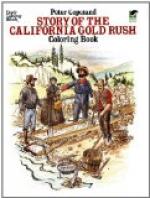A salt-water creature very destructive to shipping and the wharves is the teredo, or ship-worm. This brown inch-long worm lives in wood that is always under water, such as the bottoms of ships and the round piles you see at the wharves. He hollows or bores out winding tunnels in the wood with the sharp edge of his shell until the piles crumble to pieces. This small animal would finally destroy the largest wooden ship if sheets of copper were not put on the sides and keel to protect it.
When Retta saw Tom’s basket of fish she said, “Well, I think the fresh-water fishes much prettier. I am sure the rainbow and Dolly Varden trout with their bright-colored spots, which we saw up in the Truckee River and the mountain lakes last summer, were better to look at and to eat than these sea monsters.” Tom laughed and said, “Oh, that was because you helped to catch some of those. Do you remember the big black-spotted trout we saw in Lake Tahoe? And the little speckled fellows we caught in that clear creek in the redwoods, and how we wrapped them in wet paper and cooked them at our camp-fire? I wish we could go up to the McCloud River, though, and see the baby trout in the fish hatchery there.”
So their mother told them that the tiny trout eggs were kept in troughs with clear, cold water running over them till they hatched out. Then the little things, not half as long as a pin, were placed in large tin cans and sent to stock brooks and lakes, and in a year or so they grew big enough to catch.
The most valuable of our food-fishes is the salmon, a large silvery-sided salt-water fish that takes fresh-water journeys too. For they swim up the rivers every year to lay their eggs in the clear, cold streams, knowing, perhaps, that the salmon-fry, as the young are called, will have fewer enemies away from the ocean. The salmon go over a hundred miles up to the McCloud River to spawn, and will jump or leap up small falls or rapids in their way. Indians spear many of them, but a number go back to the ocean again. Thousands and thousands of ocean salmon are caught along the northern coast and taken to the canneries. There the fish are put into cans and cooked, and when sealed up are sent all over the world. California salmon is eaten from Iceland to India, and its preparation and sale give employment to many people.
[Illustration: HUMPBACK WHALE (57 feet long).]
[Illustration: TROUT FROM LAKE TAHOE.]
ABOUT CALIFORNIA’S INDIANS
When the Spanish and English first landed on this part of the New World’s coast, they found the Indians who dwelt inland almost naked, and living like wild animals on roots and seeds and acorns. The tribes along the seashore, however, were good hunters and fishermen, and those Indians along the Santa Barbara Channel and the islands near by were a tall, fine-looking people, and the most intelligent of the race. They had large houses and canoes, and clothed themselves in sealskins.




